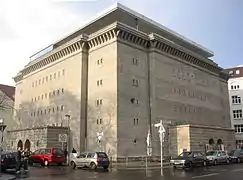Karl Bonatz
Karl Nikolaus Bonatz (1882-1951) was a German architect, best known for designing a bunker in 1943 that is now an art gallery.
.jpg.webp)
Karl Bonatz | |
|---|---|
| Born | 6 July 1882 |
| Died | 24 September 1951 (aged 69) |
| Nationality | German |
| Occupation | Architect |
| Buildings | 1905-1914: Various departments of Strasbourg City Hospital 1943: Reichsbahnbunker |
| Projects | Chief planner of West Berlin |
He was the younger brother of fellow architect Paul Bonatz.[1] The brothers presented a plan for modernising the Hôpital civil de Strasbourg and were commissioned by the city, there then home-town, to carry out the plans. After completing successively the clinic for epidemic diseases (1906), the general technical buildings (1909), the pediatric clinics (1910), the maternity clinic (1911), the neurological clinic (1912), the surgical clinic B, the medical clinic B, the radiological department and the baths (1914)[2] Karl was recruited in 1915 to serve in World War One. Thereafter he returned to Strasbourg and in 1919 he opened there his architectural firm of his own, before being expelled from France in 1921. After several stations, among others in Merseburg working in public service of the Province of Saxony he changed position and served as Magistratsoberbaurat, one of Berlin's everal equally ranked high city officials for construction, between 1927 and 1937.
In 1940 he was employed by Albert Speer in his office of inspector general for constructions in Berlin. Bonatz designed several bunkers, among them the Reichsbahnbunker (railway bunker), built in Mitte, Berlin, that could house 3,000 people.[3] Planning began in 1943, under the supervision of Albert Speer.[4]
Bonatz succeeded Hans Scharoun as chief planner of West Berlin.[1]
References
- Jeffry M. Diefendorf (24 June 1993). In the Wake of War: The Reconstruction of German Cities after World War II. Oxford University Press. pp. 376–377. ISBN 978-0-19-987939-7. Retrieved 5 March 2018.
- « Personne:Karl Bonatz », on: Archi-Wiki: Partageons la ville, ses bâtiments, ses lieux…, retrieved on 12 October 2020.
- Tzortzis, Andreas (June 12, 2007). "In a Berlin war bunker, Christian Boros creates a showcase for art". The New York Times.
- "The Bunker, Berlin - World War Two Northern Ireland". wwiini.org. Retrieved 5 March 2018.
